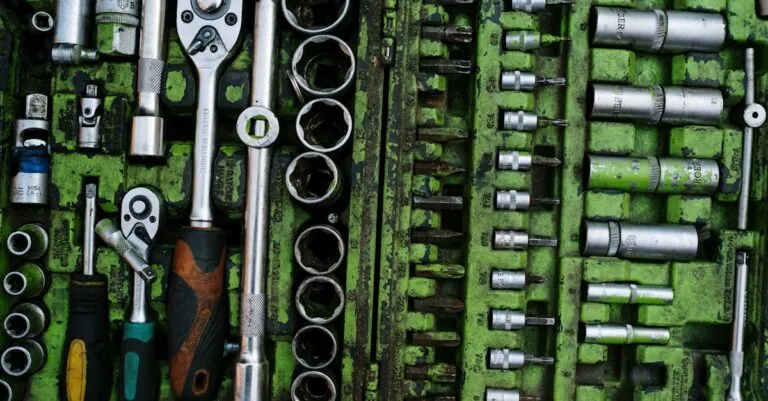Every homeowner knows that a well-stocked tool kit is the secret weapon in the battle against pesky home repairs. Whether it’s fixing that leaky faucet or assembling furniture that seems to come with a PhD in engineering, having the right tools at your fingertips makes all the difference. It’s like having a superhero cape—only instead of saving the world, you’re saving yourself from endless trips to the hardware store.
Imagine tackling projects with confidence, armed with everything you need to conquer DIY disasters. A home tool kit isn’t just a collection of gadgets; it’s a ticket to home improvement glory. So why settle for a haphazard drawer of mismatched tools when you can equip yourself with the essentials? Let’s dive into the must-have items that’ll turn any homeowner into a DIY dynamo, one hilarious mishap at a time.
Table of Contents
ToggleWhat Is a Home Tool Kit?
A home tool kit is a collection of essential tools designed for basic maintenance and repair tasks around the house. Homeowners rely on these kits to handle a variety of projects without the need for constant trips to the hardware store. Key tools within a home tool kit typically include items for construction, repairs, and assembly.
Commonly found tools in a home tool kit encompass a hammer, screwdrivers, pliers, a tape measure, and a utility knife. Hammers come in various styles but usually feature a forged steel head and a sturdy handle. Screwdrivers include both flathead and Phillips options, making them versatile for different screws. Pliers facilitate gripping and twisting, essential for securing wires or small pieces. A tape measure measures lengths accurately, ensuring precision in every task.
Some tool kits also feature more specialized items like levels and wrenches. Levels verify that surfaces are even, which is crucial for hanging shelves or pictures. Wrenches adjust to fit various nut and bolt sizes, allowing for easy assembly or disassembly of furniture.
Storage is vital for a home tool kit. Portable toolboxes or organizers keep tools neatly arranged, making them easy to find during emergencies. Durable materials ensure that tools remain protected from wear and tear, extending their lifespan.
Equipping a home tool kit empowers homeowners to undertake DIY projects confidently. With all the necessary tools at hand, tackling repairs becomes less daunting. An organized, comprehensive tool kit fosters a sense of accomplishment and efficiency for any home repair and improvement endeavor.
Essential Tools in a Home Tool Kit
A well-equipped home tool kit contains various essential tools for efficient home repairs and DIY projects. Homeowners can handle multiple tasks with confidence when they have these tools readily available.
Hand Tools
Common hand tools include hammers, screwdrivers, pliers, and tape measures. Each tool serves a unique purpose, making it easier to perform repairs. Hammers provide leverage for driving nails, while screwdrivers come in flathead and Phillips varieties for different screws. Pliers assist with gripping or cutting wire. Tape measures ensure accurate measurements for precise installations. Utility knives are versatile, cutting through various materials. Keeping these tools organized enhances accessibility, making home improvement tasks smoother.
Power Tools
Power tools add efficiency and speed to home projects. Drills enable quick hole-making in wood or drywall, accommodating various bit sizes. Saws, like circular and reciprocating models, cut through wood and metal accurately. Sanders smooth surfaces, while grinders handle rust or paint removal tasks. Every homeowner benefits from a power tool such as a jigsaw for intricate cuts or an impact driver for high-torque applications. Using power tools properly improves safety and results, making DIY projects less daunting.
Benefits of Having a Home Tool Kit
A home tool kit streamlines repair tasks, allowing homeowners to tackle projects efficiently. Convenience ranks high among benefits; having essential tools on hand reduces the need for frequent trips to the store. Cost savings emerge as another advantage, as homeowners can manage minor repairs without hiring professionals.
Time savings also play a significant role. Quick fixes can occur instantly, preventing delays in addressing issues. Flexibility stands out as well; with a tool kit, homeowners can handle unexpected projects anytime.
Confidence grows alongside experience. Homeowners often become more self-sufficient, gaining skills through practice. This empowerment leads to a sense of accomplishment when completing tasks independently.
Organization simplifies home improvement efforts. A well-structured tool kit allows easy access to tools, encouraging more frequent use. Longevity of tools enhances this benefit; a home tool kit supports maintenance over time.
Improved safety remains a critical consideration. Without proper tools, DIY projects may pose risks. Each tool fulfills a specific purpose, ensuring tasks are completed accurately and safely.
Community engagement can also flourish through shared experiences. Homeowners may invite neighbors over for collaborative projects, building camaraderie. Sharing knowledge enhances the sense of community, fostering connections between neighbors.
Ultimately, having a home tool kit equips homeowners with invaluable resources, enhancing their ability to manage home repair tasks. This readiness leads to greater satisfaction in maintaining one’s living space.
Tips for Choosing the Right Home Tool Kit
Selecting the appropriate home tool kit involves several key considerations. Assessing your specific needs helps identify which tools are essential for individual projects. Assess the types of repairs or improvements planned; understanding the scope of work influences tool selection.
Consider the tool quality; investing in durable tools ensures longevity and effectiveness. Look for reputable brands known for reliability and performance. Check for user reviews, as these insights provide real-world opinions about the tools’ effectiveness and usability.
Evaluate the kit’s contents; a well-rounded tool kit should include diverse hand and power tools. Essential hand tools include hammers, screwdrivers, pliers, and tape measures, while power tools, like drills and saws, enhance efficiency for larger projects. Even specialized tools like levels or wrenches may prove beneficial for precise tasks.
Organizational features cannot be overlooked; choose a tool kit that includes a portable toolbox or storage solutions. Proper organization keeps tools accessible and helps avoid clutter, simplifying each project.
Assess your budget; tool kits vary widely in price. Balancing cost and quality aids in making informed decisions while sticking to financial plans. Discounts or bundled offers can maximize value without sacrificing tool quality.
Additionally, think about future needs; a versatile tool kit adapts to different tasks as DIY skills develop. Opting for modular or expandable kits allows for easy addition of tools over time, meeting evolving requirements in home repair and maintenance.
Maintaining Your Home Tool Kit
A home tool kit requires regular maintenance to ensure all tools remain functional and accessible. Start by inspecting each tool for signs of wear, rust, or damage. Checking for these issues helps identify which items need replacement or repair.
Storage plays a vital role in maintaining your tool kit. Organizing tools neatly in labeled containers or portable toolboxes minimizes clutter and makes locating items easier. Utilizing drawer organizers also keeps tools segregated by type or function, enhancing efficiency during projects.
Cleaning tools regularly is essential. Wiping down surfaces after each use prevents dirt buildup and corrosion. Additionally, applying lubricant to moving parts on tools, such as hinges and blades, extends their lifespan.
Keeping a checklist of tools and their condition is beneficial. Regular updates on your inventory can help track necessary replacements and ensure that the kit remains well-stocked. Noting which tools are frequently used also aids in prioritizing any upcoming purchases.
Replenishment of supplies is key to an effective tool kit. Basic items such as screws, nails, and tape should be regularly assessed and restocked to avoid interruptions during projects. Planning regular assessments of these supplies prevents last-minute trips to the store.
Overall, maintaining a home tool kit enhances productivity. Homeowners can address projects more seamlessly, knowing that tools are ready for use. Commit to regular evaluations to keep the toolkit in prime condition.
A well-equipped home tool kit is an essential asset for any homeowner. It not only simplifies repairs but also fosters a sense of independence and confidence in tackling DIY projects. By investing in quality tools and maintaining them properly, homeowners can ensure they’re always prepared for unexpected tasks.
The right tools not only enhance efficiency but also elevate the overall satisfaction of home improvement efforts. With a well-organized tool kit, homeowners can navigate repairs with ease, ultimately transforming their living spaces while building valuable skills along the way. Embracing the DIY journey can lead to rewarding experiences and stronger connections within the community.








